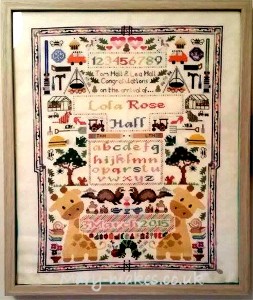Small Hall
Our niece arrived one chilly evening in March, in anticipation of this event I decided that the obvious thing to do was to embroider her a sampler. A sampler is traditionally a sewn demonstration of needlework, and from the 18th century onward these often included alphabets, pictures and the like, all in cross stitch. A sampler was often used to commemorate a birth or marriage or a family at a point in time. The one that I set out to make for Small Hall would record her parents, their interests and lives just at the point of her birth, as the first grandchild of the family.
Planning
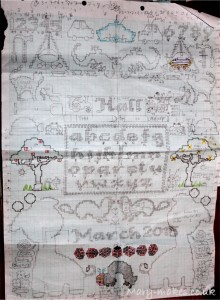
No bit of successful cross stitch starts at random, some planning was required. This work would be completed on aida, a evenly, open woven fabric, used counted cross stitch – that is cross stitch whose pattern is followed by counting the number of stitches in each row or block, rather than a print on the fabric. I’ll not bore you with the how to element, the Cross Stitch Guild is full of helpful information about how to get started.
By way of a design brief, this pattern had to show the interests and exploits of my brother and his wife – including: giraffes, caving helmets, light sabres, trees, green houses, steam engines, cats, frogs, weasels, the very hungry caterpillar, gardening, teaching and at least one of their cars. It also had to be symmetrical, with names and dates in the middle, showing that Small was from two parts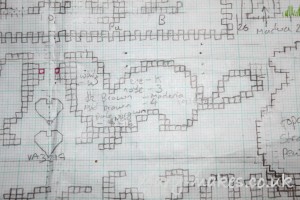 of a family. A list of possible pictures and images, a propelling pencil and lots of A3 graph paper was where the design proper began. Followed by extensive googling for patterns – ever tried to find a pattern of a weasel in counted cross stitch? Me neither, until this started…. I had help from my mother-in-law, who lent me books of cross stitch patterns which helped me with the patterns for tools, leaves, squirrels and trees etc. I also found a very handy online tool to calculate the spacing and letters required for
of a family. A list of possible pictures and images, a propelling pencil and lots of A3 graph paper was where the design proper began. Followed by extensive googling for patterns – ever tried to find a pattern of a weasel in counted cross stitch? Me neither, until this started…. I had help from my mother-in-law, who lent me books of cross stitch patterns which helped me with the patterns for tools, leaves, squirrels and trees etc. I also found a very handy online tool to calculate the spacing and letters required for 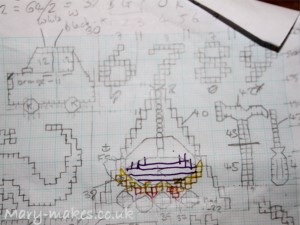 words and numbers in different sizes and type faces at CrossStitch.com. A few patterns had to be custom drawn, including the griddle (and long veteran of family BBQs and an heirloom of my great grandparents) , fire, tiara, a Speen Snail and steam engine.
words and numbers in different sizes and type faces at CrossStitch.com. A few patterns had to be custom drawn, including the griddle (and long veteran of family BBQs and an heirloom of my great grandparents) , fire, tiara, a Speen Snail and steam engine.
Colouring
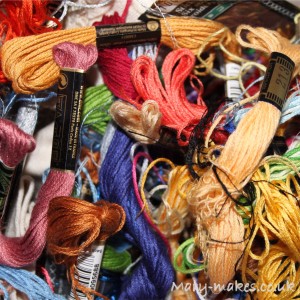 I have a lot of embroidery thread, I mean a lot. Bits left over from previous works, the contents of inherited sewing boxes, a friendship bracelet obsession in Year 5, bundles picked up a charity shops and flea markets.
I have a lot of embroidery thread, I mean a lot. Bits left over from previous works, the contents of inherited sewing boxes, a friendship bracelet obsession in Year 5, bundles picked up a charity shops and flea markets.
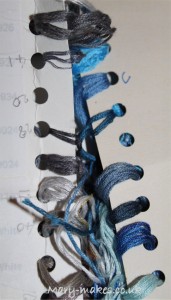
Despite the chaos that the photo suggests, when I started colouring the pattern, the loose threads got sorted, by colour into hole punched cards and tied with a larks head knot. As each part of the pattern was sorted out, either the serial number of 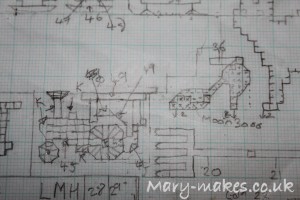 the hank of thread or a reference number written on the punched card was noted on the pattern. In the hope that I would remember the colours I’d chosen when I came to actually start sewing. This mostly worked.
the hank of thread or a reference number written on the punched card was noted on the pattern. In the hope that I would remember the colours I’d chosen when I came to actually start sewing. This mostly worked.
Sewing
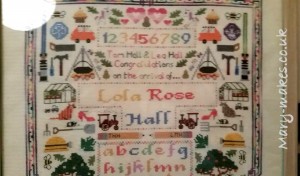
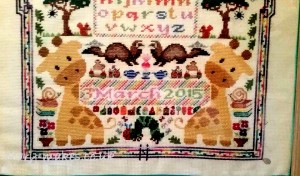 The aida was stretched out onto a frame to help keep it in place and to keep the stitches tension even, before being sewn onto the frame and rolled into place. The tricky bit of counted cross stitch is the counting. Sometimes things didn’t quite count out as the pattern intended, and my plan to leave two rows of Aida empty between each picture. Bits of this didn’t always come out just right. Which was a tad annoying. To solve this, I added in extras to fill in the gaps – little butterflies, oak leaves or acorns, following the general sub theme of the outdoors and new life. As a result of the intermittently accurate counting, the border had a bit of a kink in the middle. As a point of interest, the border is four rows of multicolour thread, two rows in pink, blue, turquoise and yellow and two in purple to white ombre, with a monogram at the top of the letters H A L L.
The aida was stretched out onto a frame to help keep it in place and to keep the stitches tension even, before being sewn onto the frame and rolled into place. The tricky bit of counted cross stitch is the counting. Sometimes things didn’t quite count out as the pattern intended, and my plan to leave two rows of Aida empty between each picture. Bits of this didn’t always come out just right. Which was a tad annoying. To solve this, I added in extras to fill in the gaps – little butterflies, oak leaves or acorns, following the general sub theme of the outdoors and new life. As a result of the intermittently accurate counting, the border had a bit of a kink in the middle. As a point of interest, the border is four rows of multicolour thread, two rows in pink, blue, turquoise and yellow and two in purple to white ombre, with a monogram at the top of the letters H A L L.
And, after approximately 6 months of sewing (and box setting my way through one or two TV series), here we are:
